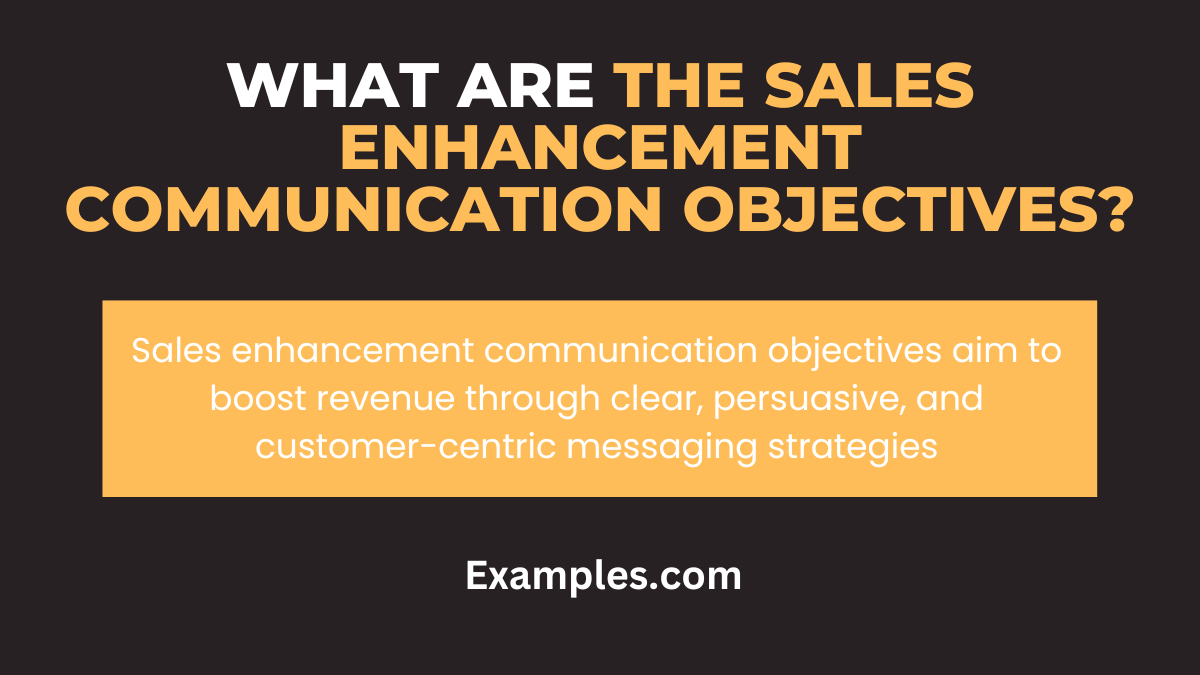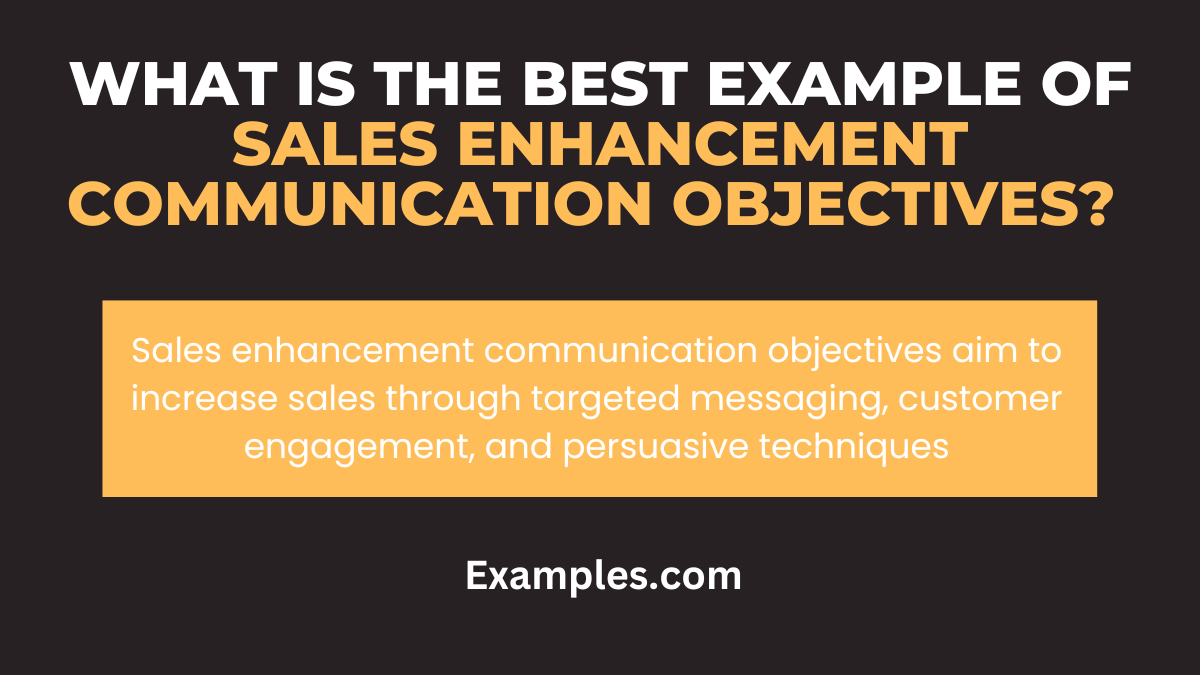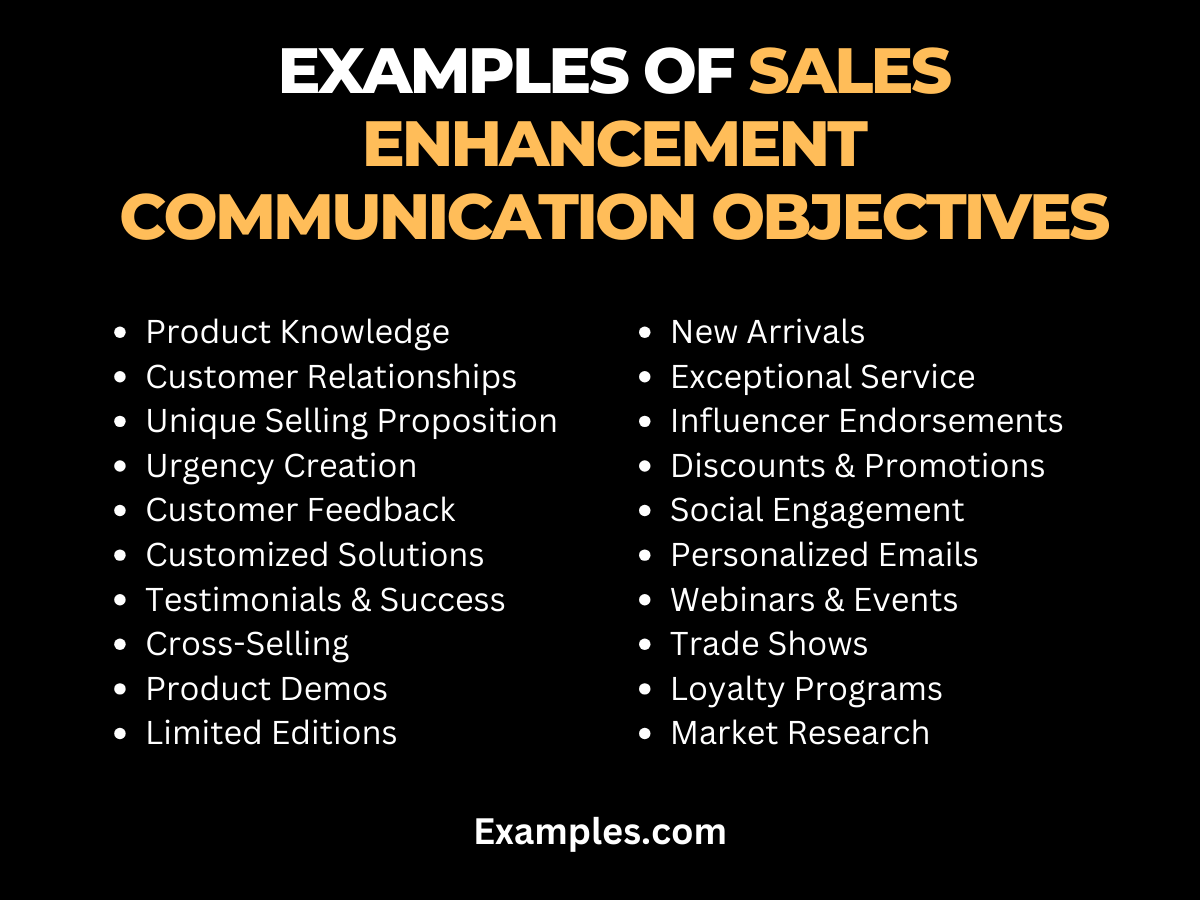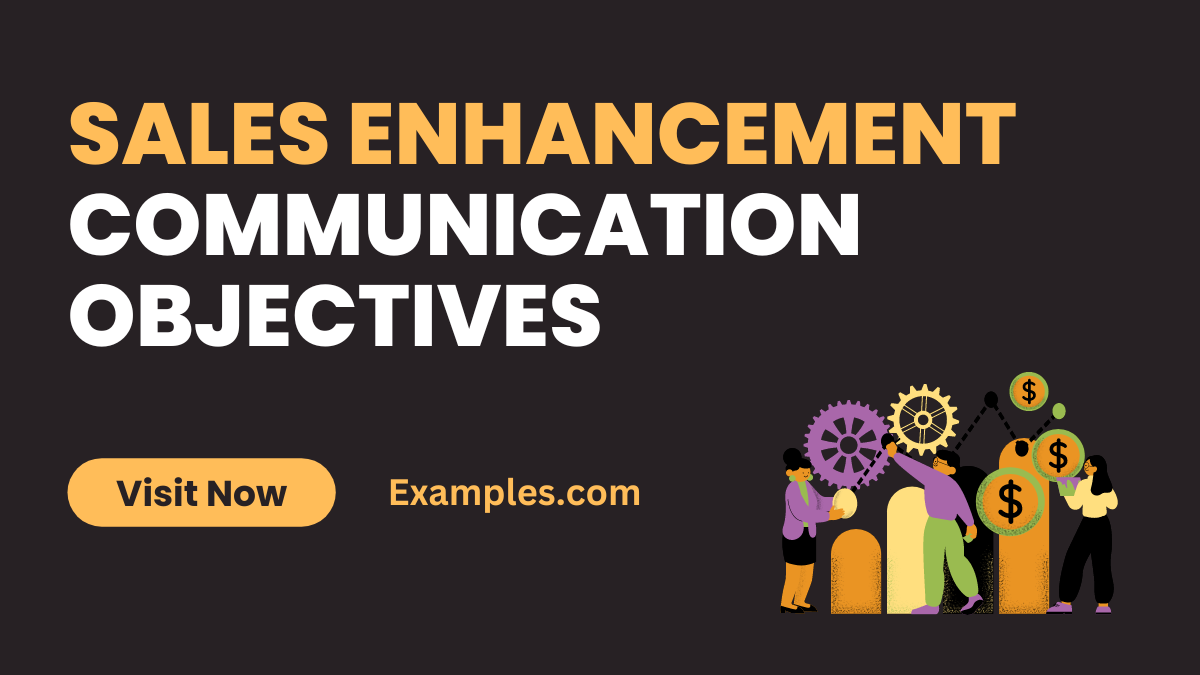19+ Sales Enhancement Communication Objectives Examples
In the dynamic realm of sales, mastering Sales Enhancement Communication Objectives is key to unlocking business growth and success. This guide dives deep into strategies that harmonize communication skills with sales objectives. Learn to articulate your value proposition, engage effectively with clients, and drive sales performance through targeted communication strategies. Perfect for professionals keen on elevating their sales game, this guide offers actionable insights and techniques to transform communication into a powerful sales tool.
What are the Sales Enhancement Communication Objectives?

Sales Enhancement Communication Objectives focus on utilizing strategic communication to boost sales. These objectives align messaging with sales goals, ensuring that every interaction moves a customer closer to a purchase. They involve understanding customer needs, effectively presenting products or services, and persuading customers through clear, convincing communication.
What is the Best Example of Sales Enhancement Communication Objectives?

A prime example is a targeted email campaign that communicates the unique benefits of a product to a specific customer segment, leading to increased interest and sales conversions. This approach combines market research, customer understanding, and persuasive messaging to achieve sales targets.
20 Examples of Sales Enhancement Communication Objectives

Sales enhancement communication objectives are strategies designed to boost sales by improving interactions with customers. These objectives focus on educating customers about products, building long-term relationships, highlighting unique selling points, creating urgency, and soliciting feedback for continuous improvement. Effective sales communication also involves personalizing customer experiences, leveraging testimonials, and employing digital engagement tactics to foster trust and encourage purchases, ultimately driving sales growth.
- Increasing Product Knowledge: Enhance sales by educating customers about product features.
Example: “Our new product has these unique features that address your specific needs.” - Building Customer Relationships: Establish trust to encourage repeat business.
Example: “We value your continued support and are here to assist you anytime.” - Highlighting Unique Selling Propositions (USP): Differentiate products from competitors.
Example: “What sets our product apart is its innovative design.” - Creating a Sense of Urgency: Encourage immediate purchases through time-sensitive offers.
Example: “This special offer is only available for a limited time.” - Soliciting Customer Feedback: Use feedback to improve products and customer satisfaction.
Example: “We’d love to hear your thoughts on how we can serve you better.” - Offering Customized Solutions: Tailor communication to meet individual customer needs.
Example: “Based on your preferences, we recommend this customized solution.” - Utilizing Testimonials and Success Stories: Build credibility through customer experiences.
Example: “Hear how our product helped others achieve their goals.” - Implementing Cross-Selling Strategies: Recommend complementary products.
Example: “Customers who bought this also found these items helpful.” - Conducting Product Demonstrations: Show the practical use and benefits of products.
Example: “Let me show you how this product works and its benefits.” - Promoting Limited Edition Products: Create exclusivity to enhance interest.
Example: “Be one of the few to own this limited edition item.” - Announcing New Arrivals: Keep customers informed about the latest products.
Example: “Check out our latest arrivals, designed to meet your evolving needs.” - Providing Exceptional Customer Service: Enhance satisfaction and loyalty.
Example: “We’re here to ensure you have the best experience with our products.” - Using Influencer Endorsements: Leverage influencer credibility to boost sales.
Example: “See why industry experts recommend our product.” - Offering Discounts and Promotions: Attract customers with special offers.
Example: “Enjoy a special discount on your next purchase with us.” - Engaging Through Social Media: Connect and interact with customers online.
Example: “Join our community online for exclusive updates and offers.” - Sending Personalized Emails: Personalize communication for more effective engagement.
Example: “We’ve selected some products especially for you.” - Hosting Webinars and Online Events: Educate and engage customers virtually.
Example: “Join our webinar to learn more about these exciting solutions.” - Participating in Trade Shows and Events: Showcase products in industry events.
Example: “Meet us at the event to explore our latest innovations.” - Leveraging Customer Loyalty Programs: Reward repeat customers to encourage more purchases. Example: “As a loyal customer, you’re eligible for exclusive rewards.”
- Conducting Market Research: Understand customer needs for targeted communication.
Example: “Help us understand your needs better to serve you more effectively.”
What are Smart Objectives of Sales Enhancement Communication?
- Increase Customer Reach: Expand the customer base by targeting new demographics and markets.
- Boost Product Awareness: Elevate awareness of products or services among potential customers.
- Enhance Brand Image: Strengthen the brand’s reputation and customer perception.
- Improve Customer Engagement: Foster deeper engagement with existing and potential customers.
- Drive Sales Conversions: Convert customer interactions into actual sales.
- Maximize Revenue Growth: Achieve higher sales revenue through strategic communication.
- Strengthen Customer Loyalty: Encourage repeat business and customer loyalty.
- Gather Customer Feedback: Collect and utilize customer feedback for continuous improvement.
Sales Enhancement Communication Objectives in Advertising
- Create Compelling Messages: Develop messages that resonate and motivate potential buyers.
- Targeted Advertising: Reach the right audience through targeted advertising campaigns.
- Promote Unique Selling Points: Highlight what sets the product or service apart.
- Leverage Social Proof: Use testimonials and reviews to build trust.
- Utilize Multi-Channel Strategies: Employ a mix of media channels for broader reach.
- Offer Promotions and Discounts: Attract customers with special offers.
- Measure Campaign Effectiveness: Track the impact of advertising on sales.
- Adapt and Optimize: Continuously refine advertising strategies based on performance.
Sales Enhancement Communication Objectives at Workplace
- Team Alignment: Ensure all team members are aligned with sales goals.
- Training and Development: Continuously train staff in effective sales techniques.
- Clear Messaging: Develop clear, consistent messaging across the team.
- Feedback and Adaptation: Regularly gather and act on sales feedback.
- Collaborative Selling: Promote teamwork in approaching sales challenges.
- Motivate and Incentivize: Keep the sales team motivated with incentives.
- Leverage Customer Insights: Use customer data to inform sales strategies.
- Foster a Customer-Centric Culture: Encourage a culture focused on customer needs.
Incorporating effective sales enhancement communication objectives can significantly boost revenue. To write compelling sales content, focus on clear messaging, customer needs, and persuasive language. Employ these tips to create a powerful sales strategy, connecting with your audience and driving sales success.



